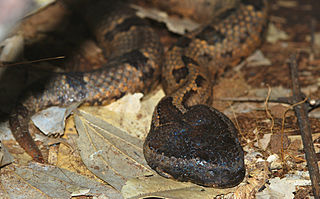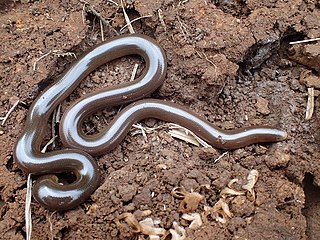
Ovophis monticola, commonly known as the Chinese mountain pit viper, is a venomous pitviper species found in Asia. Currently, two subspecies are recognized, including the nominate subspecies described here. Recent taxonomic work suggests that most of these should be considered as separate species. IUCN has already evaluated O. m. makazayazaya as Ovophis makazayazaya.

Uropeltis maculata, also known commonly as the spotted earth snake and the spotted shieldtail, is a species of nonvenomous snake in the family Uropeltidae. The species is endemic to southern India. There are no subspecies that are recognized as being valid.
Uropeltis rubrolineata is a species of nonvenomous shieldtail snake in the family Uropeltidae. The species is endemic to southern India. There are no subspecies that are recognized as being valid.
Letheobia simonii is a blind snake species endemic to the Middle East. No subspecies are currently recognized.
Hypoptophis is a monotypic genus created for the rear-fanged (opisthoglyphous) mildly venomous snake species, Hypoptophis wilsonii. The species, which is endemic to Africa, is in the subfamily Aparallactinae of the family Atractaspididae. There are no subspecies that are recognized as being valid.

Macrelaps is a monotypic genus created for the rear-fanged (opisthoglyphous) venomous snake species, M. microlepidotus, endemic to South Africa. No subspecies are currently recognised.
The Cameroon racer, Poecilopholis cameronensis, is a species of rear-fanged mildly venomous snake endemic to Africa. Poecilopholis is a monotypic genus created for this species.
Polemon acanthias, or Reinhardt's snake-eater, is a species of mildly venomous rear-fanged snake in the family Atractaspididae. It is endemic to Africa.

Leptotyphlops distanti, also known commonly as Distant's thread snake or Distant's worm snake, is a species of snake in the family Leptotyphlopidae. The species is native to Southern Africa.
Leptotyphlops telloi, also known commonly as Tello's threadsnake or Tello's worm snake, is a species of snake in the family Leptotyphlopidae. The species is indigenous to southern Africa.

Aparallactus guentheri, or the black centipede-eater, is a species of mildly venomous rear-fanged snake in the family Atractaspididae. The species is endemic to Africa.

Aparallactus modestus, or the western forest centipede-eater, is a species of mildly venomous rear-fanged snake in the Atractaspididae family.
Aparallactus nigriceps, or the Mozambique centipede-eater, is a species of mildly venomous rear-fanged snake in the family Atractaspididae.
Aparallactus werneri, or the Usambara centipede-eater, is a species of mildly venomous rear-fanged snake in the family Lamprophiidae. The species is endemic to Tanzania.

Rhinotyphlops schinzi, commonly known as Schinz's beaked blind snake, is a species of snake in the family Typhlopidae. The species is endemic to southern Africa.
Letheobia somalica, also known as the highland beaked snake or Ethiopian blind snake, is a species of snake in the family Typhlopidae. It is endemic to Ethiopia.
Rhinotyphlops unitaeniatus, commonly known as the yellow-striped blind snake or the Kenya beaked snake, is a species of snake in the Typhlopidae family. It is endemic to Africa.

Bibron's blind snake is a species of snake in the family Typhlopidae. The species is native to southern Africa.
Fornasini's blind snake is a species of snake in the family Typhlopidae. The species is endemic to southern Africa.

Afrotyphlops schlegelii, commonly known as Schlegel's beaked blind snake or Schlegel's giant blind snake, is a species of snake in the family Typhlopidae. The species is endemic to eastern and southern Africa, and bears the distinction of being the world's largest typhlopid. It is harmless to humans and lives exclusively on a diet of termites.










